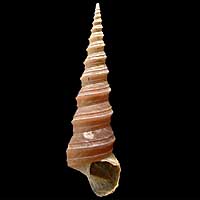|
< Previous family introduction |
|
||||||||||||||||||||||||||||||||||||||||||||||||||||||||||||||||||||||||||||||||||||||||||||||||||||||||||||||||||
 |
Family Turritellidae Screw Shells
|
||||||||||||||||||||||||||||||||||||||||||||||||||||||||||||||||||||||||||||||||||||||||||||||||||||||||||||||||||
|
Shells of the Turritellidae are elongate with many whorls, similar in shape to the Terebridae. The family consists of about a thousand species, world wide in distribution, but more speciose in temperate seas. They generally live subtidally, down to at least 1500 metres, but a few occur in the lower intertidal. The family is well represented in Australia, with about 27 species occurring here. Animals of this family are ciliary deposit feeders with limited crawling ability. They lay upon or are partly buried in the substrate, usually soft muddy-sand, and filter minute particles from the sea water as it is drawn over their gills. The particles are then fed in a mucous string to the mouth. The Australian species Gazameda gunnii supplements its food during times of low plankton availability by scavenging, and this may occur in other members of the family. In this family some species are dioecious, meaning they exist as male or female throughout their life, while others are protandric hermaphrodites, meaning that animals start life as males and change to females. Sperm may be transferred from male to female in packets, or broadcast into the water by males and captured by females in the inhalant water stream. In some species fertilized eggs are brooded in the mantle cavity of the female, with juveniles either being released into the plankton or released onto the substrate as crawling juveniles. Other species attach the egg mass to wood, rocks or other solid substrate, from whence they hatch. There are 18 species of this family in NSW, varying in size from 6.5 to 90 mm in length. They all occur subtidally, some in relatively shallow water down to about 100 m, while others are among the deepest living molluscs in the NSW fauna, occurring down to at least 1500 m. They are do not live intertidally in NSW; shells are occasionally washed up on beaches, more commonly in the far south of the state. Of the 18 species, all except one has an eastern or southern Australian distribution. The exception is Haustator cingulifer, which occurs in the tropical Indo-West Pacific and just reaches southwards to Sydney. One species, Maoricolpus roseus, is introduced from New Zealand, and is spreading northwards up the NSW coast. Family Reference Garrard, T.A. 1972. A revision of Australian Recent and Tertiary Turritellidae (Gastropoda: Mollusca). Journal of the Malacological Society of Australia, 2(3): 267-338. Coverage All species of Turritellidae recorded from NSW are detailed here. Identification Notes Turritellids are elongate, many whorled shells, similar to the terebrids in general shape but distinguished by not having either an anterior or a posterior canal. The outer lip bears a large sinus, but the lip in the sinus area is very thin and usually broken, even in life. The shape of the sinus is best seen in the growth lines behind the growing edge. There is strong spiral sculpture, but axial sculpture is restricted to growth lines of the shape of the outer lip. There is a smooth protoconch of 1½ - 2 ½ whorls in the NSW species, after which the adult, or teleoconch, whorls begin. The teleoconch whorl on which spiral ribs begin, and the sequence in which they commence, is diagnostic for the species, but has not been used here as it requires close microscopic examination of specimens in good condition. Instead, the sculpture of the last few whorls is described. Much use is made in the species descriptions of the terms rib, riblet, and thread. These are imprecise comparative terms to describe sculpture on the surface of the shells; ribs are larger than riblets which are in turn larger than threads. A keel is a type of rib which is tall and parallel-sided. The following table arranges the NSW species by maximum shell length, as an aid to identification. Note that the abundance and beach washup information is specific to NSW. Some species are much more common outside NSW, such as Haustator cingulifer which is a tropical species and abundant in Queensland, and Colpospira australis which is commonly found in beach washup in Tasmania.
|
||||||||||||||||||||||||||||||||||||||||||||||||||||||||||||||||||||||||||||||||||||||||||||||||||||||||||||||||||
|
|||||||||||||||||||||||||||||||||||||||||||||||||||||||||||||||||||||||||||||||||||||||||||||||||||||||||||||||||||